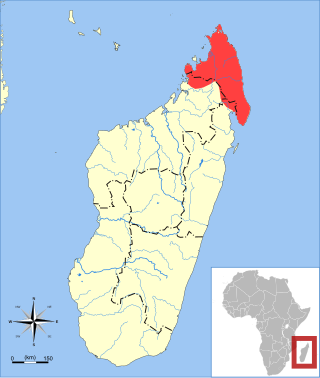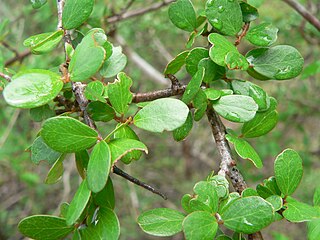
Ravenala is a genus of monocotyledonous flowering plants. Classically, the genus was considered to include a single species, Ravenala madagascariensis, commonly known as the traveller's tree, traveller's palm or East-West palm, from Madagascar. It is not a true palm but a member of the family Strelitziaceae. The genus is closely related to the southern African genus Strelitzia and the South American genus Phenakospermum. Some older classifications include these genera in the banana family (Musaceae). Although it is usually considered to be a single species, four different forms have been distinguished. Five other species were described in 2021, all from Madagascar: Ravenala agatheae Haev. & Razanats., R. blancii Haev., V.Jeannoda & A.Hladik, R. grandis Haev., Razanats, A.Hladik & P.Blanc, R. hladikorum Haev., Razanats., V. Jeannoda & P.Blanc, R. madagascariensis Sonn., et R. menahirana Haev. & Razanats.

Sanzinia madagascariensis, also known as the Madagascar tree boa or Malagasy tree boa, is a boa species endemic to the island of Madagascar. It was once considered conspecific with the Nosy Komba ground boa. Like all other boas, it is non-venomous.

Acrantophis madagascariensis is a species of boid snake in the subfamily Sanziniinae that is endemic to the island of Madagascar. Its common names include the Madagascar ground boa and Malagasy ground boa.

The Far Eastern curlew is a large shorebird most similar in appearance to the long-billed curlew, but slightly larger. It is mostly brown in color, differentiated from other curlews by its plain, unpatterned brown underwing. It is not only the largest curlew but probably the world's largest sandpiper, at 60–66 cm (24–26 in) in length and 110 cm (43 in) across the wings. The body is reportedly 565–1,150 g (1.246–2.535 lb), which may be equaled by the Eurasian curlew. The extremely long bill, at 12.8–20.1 cm (5.0–7.9 in) in length, rivals the bill size of the closely related long-billed curlew as the longest bill for a sandpiper.

Ankarafantsika National Park is a national park near Andranofasika in the Boeny Region of Madagascar. The closest city is Majunga 115 kilometres (71 mi) north of the park. Ankarafantsika is mostly tropical in climate type. The Sakalava people are the predominant ethnic group living and farming here. The greater big-footed mouse lives in the park and is not known anywhere else.

The Malagasy slit-faced bat is a species of slit-faced bat native to Madagascar. Very little is known about the species.

Sakoanala is a genus of legume in the family Fabaceae. It contains two species which are endemic to Madagascar.
Xanthocercis madagascariensis is a species of flowering plant in the family Fabaceae. It is found only in Madagascar.

Dypsis madagascariensis is a species of flowering plant in the family Arecaceae. It is found only in Madagascar. It is threatened by habitat loss.

The Malagasy bulbul is a species of songbird in the bulbul family, Pycnonotidae. It is found on Madagascar and other regional islands in the south-western Indian Ocean.

The Madagascar pygmy kingfisher is a species of bird in the family Alcedinidae. It is endemic to Madagascar and found in western dry deciduous forests.

The Madagascar rail is a species of bird in the family Rallidae.

The red-tailed silverside, or zona is a species of Madagascar rainbowfish endemic to the Mananjary River drainage in Madagascar. It is threatened by habitat loss and introduced species. It has often been confused with the related B. madagascariensis, which is common in the aquarium trade. In addition to meristics, the two can be separated by the exact colour pattern on their tail fin and the distinct red spot on the lower jaw of breeding male B. geayi. B. geayi was described in 1907 by Jacques Pellegrin from a type collected by the pharmacist and natural history collector Martin François Geay (1859-1910), who Pellegrin honoured with its specific name.
Tropodiaptomus madagascariensis is a species of calanoid copepod in the family Diaptomidae.

Khaya madagascariensis is a species of plant in the family Meliaceae. It is found in Comoros and Madagascar.
Petchia madagascariensis is a plant in the family Apocynaceae.

The Madagascar dwarf gecko is a species of gecko endemic to Madagascar.
Beccariophoenix fenestralis is a species of plant in the family Arecaceae. It was described as a species distinct from Beccariophoenix madagascariensis in 2014.
Abrus madagascariensis is a plant in the legume family Fabaceae, native to Madagascar. It grows as a herb, shrub or liana.
Pseudoacontias madagascariensis, the giant Madagascar skink, is a species of lizard which is endemic to Madagascar.















